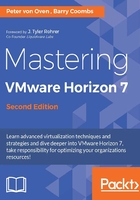
Instant Clones
The Instant Clones feature is actually a functionality built into the vSphere platform rather than a specific Horizon feature, and was made available from the vSphere 6.0 U1 release, but is only now becoming a supported feature as part of Horizon 7.
It uses the VMware VM Fork technology to very quickly provision virtual desktop machines. An instant clone is created from an already powered on and running virtual desktop machine, called the Parent VM, which is quiesced before the Instant Clone is created. This is what makes Instant Clones quicker to provision than Linked Clones with View Composer.
The Instant Clone shares its memory and its disk with the parent VM for read operations, and is created immediately, and in an already powered-on state, unlike with View Composer-based Linked Clones that have to power-on as part of the creation process. As well as sharing the memory and disk with the parent VM, the Instant Clone has its own unique memory and delta disk file.
The following diagram shows the Instant Clone architecture:

When the end user logs off the Instant Clone virtual desktop machine, it is destroyed, and when the user logs on again they will have a new Instant Clone created. If they need any data to persist then they would use the Writeable Volume feature of App Volumes to deliver that functionality and UEM to manage their personalization settings.
Note
To take advantage of Instant Clones, the virtual desktop machines will need to be running virtual machine hardware version 11 or higher.
There are a number of benefits to using Instant Clones when compared with Linked Clones:
- Instant Clones provision in seconds compared to minutes for Linked Clones
- Boot Storms are eliminated as the parent desktop is powered on, and all Instant Clones are created in an already powered-on state
- No requirement to perform refresh or recompose operations as desktops have a short lifecycle
- Patching the operating system requires you to just update the parent VM, rather than running a recompose operation, resulting in an end user receiving the updated virtual desktop machine on their next log on automatically
- Lessens the load on the vCenter server
- No requirement for SE Spare Disk or CBRC
Given that Instant Clones is still a relatively new technology, there are a couple of limitations that you should be aware of:
- RDSH servers are not currently supported-use Linked Clones instead.
- Only supports Windows 7 and Windows 10.
- Only supports floating desktop pools. No support for dedicated pools.
- Maximum of 2000 desktops.
- Only supports a single vCenter and single vLAN.
- No support for vGPU or vDGA, but limited support for vSGA.
- VSAN or VMFS datastores only. No support for NFS.